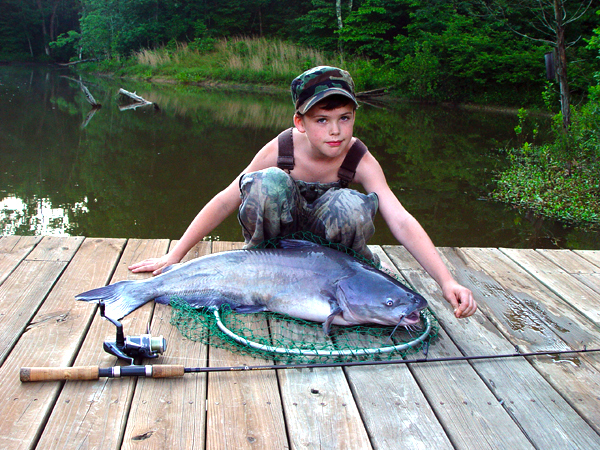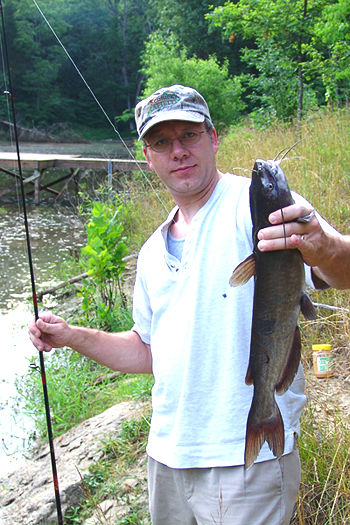
By Art Lander Jr.

FRANKFORT, Ky. – Late May is a prime time to catch catfish from Kentucky’s reservoirs, small lakes, rivers and farm ponds.
“The water is warming into the 70s and catfish are about to spawn,” said Gerry Buynak, assistant director of the Fisheries Division for the Kentucky Department of Fish and Wildlife Resources. “Beginning in late spring and throughout the summer, catfish settle into daily patterns and feed aggressively.”
Kentucky’s three most sought-after catfish species channel catfish, blue catfish and flathead catfish have slightly different feeding habits. Anglers must use the right bait, the proper rig and the correct presentation to catch each kind of catfish.

Fishing tackle is an important consideration. Many catfish anglers prefer a 6 1/2- to 7-foot medium to heavy-action spinning rod. They match it with a spinning reel spooled with 17-pound fishing line.
Circle hooks are growing in popularity among catfish anglers because most fish are hooked in the corner of the mouth. These hooks can prevent catfish from swallowing the hook. With circle hooks, an angler just needs to keep the rod tip up and begin reeling. There is no need to set the hook.
The channel catfish (Ictalurus punctatus) is the most widely distributed catfish species in Kentucky. It thrives in ponds and small lakes. Channel catfish have bluish-silver backs, silvery sides and a whitish belly. They rarely exceed 30 inches.
Anglers must fish their baits on the bottom to catch channel catfish. That’s because channel catfish are scavengers. They cruise the bottom, using their super-sensitive whiskers to detect the odors of live and dead prey.
The basic slip sinker rig is the best choice for bottom fishing. Tie a No. 2 circle hook onto an 18- to 24-inch leader. Tie the other end of the leader to a barrel swivel. On the line from the rod, thread a – to-1-ounce sinker, then tie the line to the other eyelet of the barrel swivel. Thread a plastic bead onto the main line between the sinker and the swivel to help prevent the sinker from damaging the knot that connects the main line to the barrel swivel.
Fish won’t feel any resistance when they pick up the bait since the line will slip through the weight. Night crawler worms, shrimp, chicken livers or scented dough are excellent baits for channel catfish.
The blue catfish (Ictalurus furcatus) occurs naturally in the state’s biggest rivers, including the Mississippi and lower Ohio. They also occur in Kentucky and Barkley lakes. Kentucky Fish and Wildlife biologists have successfully stocked these fish in smaller lakes around the state as well.
Anglers may confuse the blue catfish with a channel catfish. The most obvious difference is the channel catfish has a rounded anal fin; the blue catfish has a straight anal fin. Blue catfish are bluish-gray with deeply-forked tails.
Blue catfish tend to roam in loose schools. At night, dusk and dawn, they frequent the shallows; they move to deeper water during the day.
Popular baits for blue catfish include cut-up gizzard shad, bluegill or minnows. Anglers fishing small lakes use a float to keep bait suspended off the bottom.
Anglers fishing in big rivers typically use a three-way swivel rig. Tie one eyelet of the swivel to the main line. Tie a two-foot leader onto a hook, and then tie this onto the second eyelet. Finally, tie a two-foot section of line to the third eyelet and attach a weight. Anglers in big waters fish the edges of channels with this rig.
The third popular species in Kentucky is the flathead catfish (Pylodictis olivaris). It inhabits large rivers and reservoirs.
Flatheads are brownish to yellowish on top and have a yellowish to white belly. They have wide, flat heads and triangular tails.
Flatheads commonly reach 36 inches in length and can live for 20 years. Adults are solitary and inhabit deep, sluggish pools during the day. They move onto rocky shallows at night, often locating around deadfalls, rock piles and stumps. They only eat live fish. Creek chubs, shiners, shad and sunfish are good baits to use.
Anglers use a modified slip rig for flatheads. Flat sinkers are used on this rig to prevent the bait from rolling. Foam floats attached to the leader keep the bait off the bottom. This prevents baitfish from swimming into cover and getting hung up.
Catfish in Kentucky are big, abundant and found in every kind of water throughout the state. For more information on where to fish in Kentucky, visit the Kentucky Fish and Wildlife website at fw.ky.gov.
Remember, too, that June 2-3 are free fishing days in Kentucky. Anglers do not need a license this weekend. Dozens of Kentucky Fish and Wildlife’s Fishing in Neighborhoods (FINs) lakes are being stocked with channel catfish in preparation for this weekend. Visit the Kentucky Fish and Wildlife website for the FINs lake nearest you.
Author Art Lander Jr. has been writing about the outdoors since the 1970s. He is a staff writer for Kentucky Afield magazine.
Media Contact: Art Lander Jr. 1-800-858-1549, ext. 4414


Be the first to comment